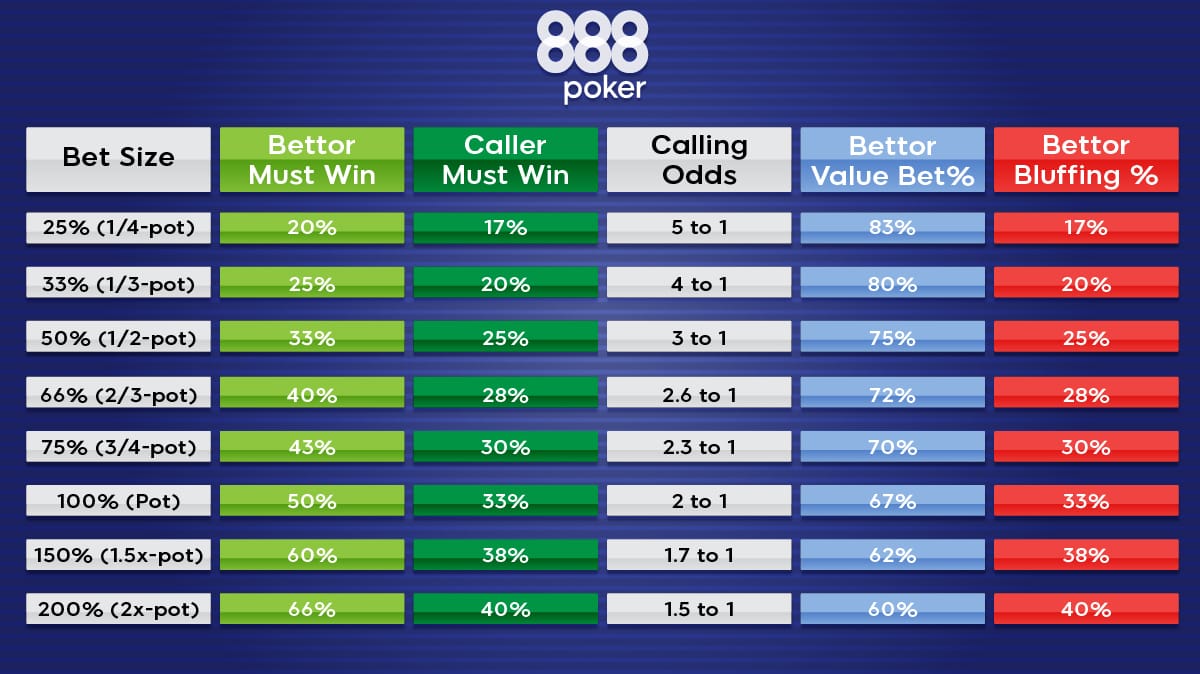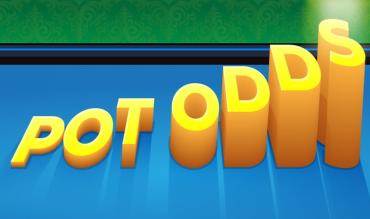In poker, pot odds relate the size of the current bet you are facing to the size of the pot, and from there help you determine if you can make a profitable call (long-term EV) with your hand, whether it’s with a draw in the middle stages of a hand or just before showdown with action on the river.
NOTE: It’s essential to be familiar with “equity” in poker to understand the scope of this pot odds article fully. Be sure to check out our equity charts article in this Poker Charts series, in case you need a refresher.
Table of Contents
Why Do I Need To Understand Poker Pot Odds
There are a couple of different reasons that you should know regarding the concept of pot odds:
- To determine if you have the “right price” currently to make a +EV call.
- To help you determine the additional money you’d have to win on future streets via implied odds if you don’t currently have the right Price.
- On the river, to help you determine the percentage of the time, you must call and win to be profitable.
- On the river, as the bettor, your bet sizing and the pot odds you lay your opponent will help you determine the optimal value to bluff ratio for hands in your range.
Note that if you are looking to call a bet on the river, if the equity of your hand against your opponent’s range is higher than the percentage of the times you need to call the river and win in order to be profitable (i.e. pot odds), then you should always call, in this instance.
Formula for Determining Pot Odds
The formula for calculating pot odds is as follows:
NOTE: Both methods lead to the same answer. Pick and choose which one you feel works best for you.
- Bet Size / (Initial Pot Size + (2 x Bet Size)) OR
- Bet Size / (New Pot Size + Bet Size)
Example: Your opponent bets $75 into a pot of $100 on the river. What are your pot odds and the percentage of the time you need to call and have the best hand?
Pot odds = $75 / ($100 + (2 x $75)
Pot odds = $75 / ($100 + $150)
Pot odds = $75 / $250
Pot odds = 0.3
Pot odds = 30%
This result means that you must win 30% of the time, if you call, to show a long-term profit.
It also means that your opponent (if they are playing ideally) should be including 70% value hands and 30% bluffs in their range when they are betting this sizing on the river.
Poker Pot Odds Chart (Related to Bet Sizings)
Use the chart below to identify all the corresponding information related to pot odds that you should be aware of, depending on the size of the bet relative to the pot size:

NOTE: Of all the charts available to you in this Chart Series, I believe that this is one of the most important ones to memorise and know off-by-hear. It’ll help simplify and make your decisions while at the table and in a hand.
Pot Odds and Live Poker
As you can see, understanding the entire chart begins with being aware of knowing the size of the pot, and the size of the bet relative to that. If you start playing poker online, it’s easier to identify these variables because they’re all clearly displayed on the screen in front of you.
In live play, it can be a bit more complicated, because you must manually calculate and recalculate the size of the pot through each stage of the hand.
Remember that the more you do something, though, the more second-nature it becomes. Therefore, directly exposing yourself to more live poker instances and being forced to keep track of pot sizes manually will all help out your cause in due course.
Once a betting round is complete, always take a moment before the next community card is dealt to recalculate the pot size silently in your head. This play will help you moving forward as you’ll always be prepared to instantaneously calculate a bet size (proportionally to the pot size), as opposed to having to backtrack and recalculate it later in the hand.
Another thing to note - always keep a sharp track of the sizings in your head. Don’t make it obvious to your opponents that you’re calculating the pot size and pot odds. If you’re facing a bet and visibly look at the pot, start counting the individual number of poker chips to determine its size with your head bobbing up and down, and then look up to the sky to apply the mathematics of the situation, it becomes quite glaringly obvious to your opponents what you’re doing.
This misstep could easily influence the range of hands they put you on for later streets (i.e. if you’re trying to see if you have the right pot odds to call with a draw).
Expressed Odds vs Implied Odds
Expressed odds refer to whether you have the correct price to call immediately (on the current street) to make it profitable in the long run.
For example, if someone makes a ½-pot bet on the flop, you must have at least 25% equity to continue based on expressed odds.
That said, you must exercise caution when calculating pot odds for flop bets. To illustrate why this is the case, suppose you want to call with a flush draw (which usually has about 36% equity).
Well, the equity that you currently have is based on both the turn and the river cards. Often, though, your opponent will fire a turn bet, too, and if your flush doesn’t get there on the turn, then you’re put in a tricky spot. Your flush draw now has about 18% equity with one card to come.
If you’re opponent bets ½-pot again, then you’d be quick to realise that you’re not getting the right immediate odds to call. (Therefore, it can be advantageous to raise with a portion of your flush draws on the flop or turn, assuming you have some sort of fold equity too. But that is a conversation for another article.)
Even if you don’t have the right price to call on the turn, you might be able to continue profitably, based on a concept called implied odds. You aim to make up the difference in EV on a later street if you make your hand.
Let’s take the “flush draw on the turn” example and see how much money we’d have to win on the river to make a turn call breakeven.
(Remember, your hand’s equity is 18%, the pot is $100, and you’re facing a $50 bet.)
METHOD 1 - Simple:
Here is the formula to use to determine how much additional money we’d need to win on the river to justify calling on the turn:
Our equity = (amount to call) / opponent’s bet + pot size + amount to call + what you will need to win on the river)
0.18 = $50 / ($50 + $100 + $50 + $X)
0.18 = $50 / $200 + $X
(0.18)($200 + $X) = $50
$36 + 0.18X = $50
0.18X = $14
X = $77.78.
METHOD 2 – Another Option:
We can determine the breakeven turn bet sizing using the formula for pot odds, and then continue from there:
Pot Odds Formula: 18% = ,(X / ($100 + 2X)
Solve for X: ($100 + 2x)(0.18) = X
$18 + 0.36X = X
$18 = X – 0.36X
$18 = 0.64X
$18 / 0.64 = 0.64X / 0.64
$28.13 = X
X = $28.13
This amount of $28.13 is how much the turn bet would have to bet for us to be getting a breakeven price to call. From here, we simply relate this to the actual $50 turn bet size we’re facing and then subtract the difference.
$28.13 / $100 = $50 / X
After we cross multiply and divide to solve for X, we see that…
X = $177.78
Because the pot size is $100 in the actual case, we see that when facing a $50 turn bet, we need the pot size to be $177.78 for a turn call to be breakeven, this means that we need to win an additional $77.78 on the river (once the pot is $200 with the call).
Now…How To Get That Money On The River
Even after we calculate how much we must win on a future street, it’s not always going to be easy to win this amount, depending on our exact situation.
Therefore, it’s vital to factor in the likelihood of you being able to extract another bet from your opponent, based on the following considerations:
- If out-of-position, we must either (1) donk bet (bet into the aggressor), in which case he might not call if we bet, as river donk ranges when draws come in, tend to be more value-heavy than bluffs, from the general population pool; or (2) check to the aggressor, and *hope* he bets, so we can either call or check-raise. Even for option #2, though, suppose he bets 25%-pot ($50) on the river and then folds to a check-raise? We still haven’t made the total $77.78 needed on the river to justify our turn call.
- If we’re in position, our opponent may check and then fold if we bet on a 3-flush river. There is no guarantee that our opponent will pay us off. Our only guaranteed hope of making it up is if our opponent will bet into us at least $77.78.
- Unless we have the nut flush, our opponent may have a better flush some percentage of the time, causing us to have had way less equity on the turn than we originally anticipated. In this case, we would lose even more money on the river.
- $77.78 relative to the $200 is still a somewhat sizeable bet, at around 40%-pot size, making opponents less likely to call. If it’s a ¼-pot sized bet that’s needed, Villain may be much more likely to pay off a bet of this size with marginal made hands (like top pair), but the larger the bet that we need to justify our turn call, the more difficult it will be to get paid.
This list helps illustrates why it’s important to play some of your draws aggressively (opponent dependent), assuming you have a decent amount of fold equity when you bet or raise the flop or turn.
In Conclusion
Understanding and applying the concept of pot odds in your poker game should become entirely automatic. The more conscious effort you put in at the beginning to comprehend and develop your “knack” for it, the easier and more second-nature it will become over time.
Thus, allowing you to make profitable, long-term winning decisions at the felts with relative ease.


